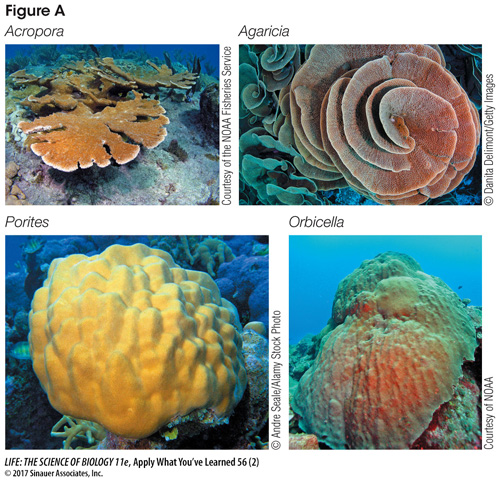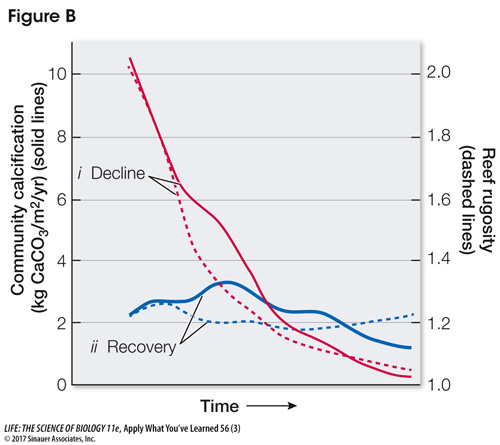Apply What You’ve Learned
Review
56.3 Indirect interactions involving three or more species can affect species diversity and abundance in communities.
56.3 Keystone, foundation, and ecosystem engineering species have major effects on community structure.
56.4 Communities recover from a disturbance through the process of succession, which results in a climax community.
56.4 Successional changes in a community are not necessarily predictable or repeatable, and may result in alternative states.
56.5 Community function can be measured by stability, which is associated with species richness.
Original Paper: Alvarez-
The calcium carbonate (CaCO3) skeletons of stony corals form the basis for coral-
Corals are undergoing serious declines because of disease, pollution, and the effects of temperature and ocean acidification related to climate change. These declines can result in rapid changes in the composition of coral communities. As the pace of climate change escalates, changes in coral communities will likely increase.
Researchers developed simplified models consisting of four coral genera from the Caribbean to study the ability of coral reefs to retain functionality with changing species composition (Figure A). They looked at reef rugosity, which is a measure of reef complexity and habitat diversity, and calcification rate, which measures how fast coral skeletons are produced. Rugosity is calculated as a ratio of the contour of the reef relative to its length. A value of 1.00 equals a flat reef; larger values represent higher rugosity.

The table shows reef rugosity and estimated calcification rate for the four coral genera. Figure B shows how reef rugosity (dotted lines) and calcification rate (solid lines) would change in coral communities through time in two models: (i) steady coral cover decline from 45 to 10 percent (red lines) and (ii) steady coral recovery from 10 to 45 percent (blue lines).

| Coral genus | Mean reef rugosity | Estimated mean calcification rate (kg CaCO3/m2/yr) |
|---|---|---|
| Acropora | 3.33 | 22.30 |
| Orbicella | 1.87 | 13.80 |
| Porites | 1.49 | 6.12 |
| Agaricia | 1.52 | 2.43 |
1226
Questions
Question 1
Based on their functions in the reef community, are corals keystone, foundation, or ecosystem engineering species? Explain your answer.
Corals are foundation species because their effects on the coral-
Question 2
According to the table, which coral genera would be most important in building the coral reef and providing habitats for other species? Which genera would be least important? Why?
The genera Acropora and Orbicella would be most important in building reef structure, and Porites and Agaricia would be least important. Acropora and Orbicella have the highest rugosity, indicating greater complexity, which results in a diversity of reef habitats. They also have the highest calcification rates, indicating that they add reef structure more rapidly than the other two genera.
Question 3
In the graph, the red lines (model i) show how reef rugosity and calcification rate would change if coral cover declined from 45 to 10 percent. Which coral genera are likely declining most rapidly, and why? How and why would the loss of these genera be likely to affect reef function and community biodiversity?
Because of the rapid decline in both reef rugosity and rate of calcification, the genera Acropora and Orbicella are likely declining most rapidly. These are the genera most responsible for the large size and complexity of the reef. The loss of these genera would affect reef function by reducing the number of habitats and thus the number and abundance of many species in the reef community.
Question 4
According to the graph, does model ii (blue lines), which shows how reef rugosity and calcification rate would change if coral cover increased from 10 to 45 percent, indicate that the reef is regaining its original functionality? On what do you base this conclusion? What factors might be affecting the reef’s ability to regain its functionality?
The reef does not appear to be regaining its original functionality, at least in the time span of the model. Although the coral cover increases from 10 to 45 percent, neither rugosity nor calcification rate shows a corresponding increase. Rugosity varies only slightly over the time span, ending with a slight upward trend. Calcification rate increases near the middle of the time period before showing a continuous downward trend. The low levels of both factors, compared with their very high levels in the original healthy reef (seen at the start of model i), indicate a much lower functionality. The low functionality may be a matter of timing; a reef’s function can be compromised when foundation species are lost (as shown in model i), but because the foundation species (massive corals such as Acropora and Orbicella) are replaced slowly, it takes much longer for the reef to recover. The lower functionality probably indicates that foundation species are being replaced by smaller species such as Porites and Agaricia, both of which have lower rugosity and calcification rates. Their effect may be significant in the short term because of their rapid reproductive rate, but less than that of Acropora and Orbicella because they do not contribute significantly to reef building.
Question 5
Are the two model coral-
Yes, both model coral-
Go to LaunchPad for the eBook, LearningCurve, animations, activities, flashcards, and additional resources and assignments.